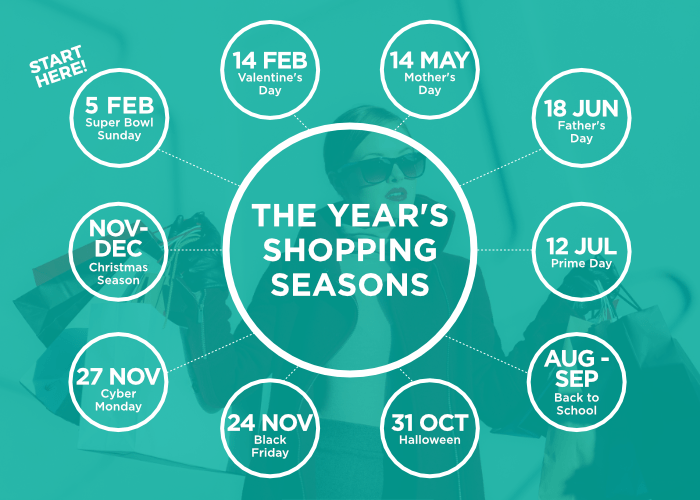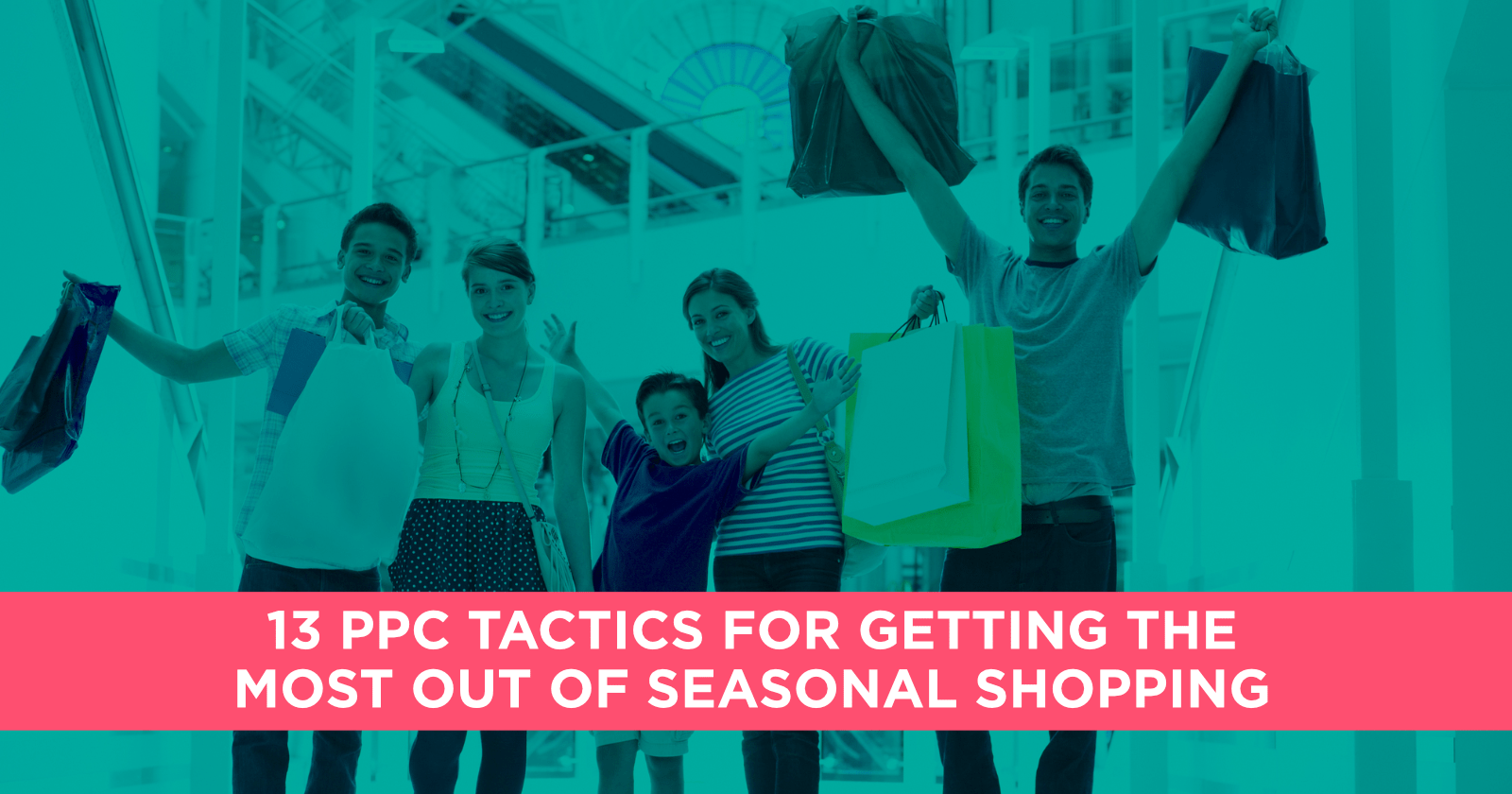There is no shortage of advice when it comes to optimizing your Google AdWords campaigns. Just Google it, and you’ll find a massive number of best practices from dozens of different sources.
But what do you do when best practices are thrown out the window? Like at Christmas or on Cyber Monday?
During certain seasons throughout the year, you can’t rely on most of the PPC tactics you’d consider best practice. Instead, you need to follow a new set of rules to get the most out of peak seasons.
Unfortunately, most e-commerce site owners don’t effectively leverage those peak seasons. They see their conversion rates go up during their high season and think they’ve nailed it.
Want to really get the most out of seasonal shopping and drive profits? Then you’ll need to leverage some powerful seasonal PPC tactics.
What Are the Top Seasons for Ecommerce?
Obviously, the peak season for your store will depend on what products you offer. Here are some of the top peak seasons in e-commerce.

Learn From Previous Years
Last year was 12 months ago. Many of us forget we’ve often been through all of this several times before. The data from last year is golden, and it’s crucial to review it before you start creating new campaigns this year.
The only caveat is that you shouldn’t set your sales benchmarks based on last year. Instead, find reusable keywords, potential bid increases, etc. But don’t let last year’s data be the deciding factor for what your budget should be or how big of a lift you can expect.
If you haven’t been all in on exploiting the seasons of the year before, then the performance from the previous year won’t set the bar very high. And, depending on your industry, your bar should be set super high!
Here are 13 PPC tactics to maximize shopping seasonality.
1. Add Broad Match, BMM & Phrase Match Keywords
If there are any keywords you only have in exact match, then a quick way to get more out of your high season is to add the same keywords in Phrase Match and Broad Match Modified. But if you already have most keywords covered in the various match types, try Broad Match keywords. They can work incredibly well during your high season.
Sometimes this will catch search queries that you would have never considered. For example, a search for a [phone roller]. Yup. Somebody misunderstood the term foam roller for a phone roller. Normally I would’ve excluded the word phone, but the search resulted in a sale. Well, I’ll be darned.
These happen all the time. During your high season, everything will convert much better. Take advantage of this and expand your footprint aggressively by using broad match keywords.
Be careful: Broad match can just as quickly go the wrong way and start showing your ad for search terms that really have no relation to what you’re selling. So remember to review your search terms for broad match keywords daily and exclude anything out of the ordinary fast.
2. Use Bid Adjustments: RLSA, Similar, Device, Demographics
Google has expanded the options we have for targeting users without actually using keywords. At the time of this writing we have the following options:
- Remarketing lists for search ads.
- Similar audiences for search ads.
- Demographics (age, gender, parental status).
- Device/day of the week/hour of day.
Use all of these to your advantage when it comes to making broad match successful.
3. Reactivate Previous High Season Keywords
There’s a big chance you have paused certain keywords throughout the year because they weren’t profitable. But during your high season all of this changes.
A quick way to identify these keywords is to change your date range and then filter for all paused ad groups and keywords. If you’re still selling the products that a keyword represents, then there is a good chance it’ll be profitable to run during your high season.
4. Add Countdowns to Your Ads
A must-have feature in AdWords during any high season is the countdown feature. This neat feature will automatically create a countdown in your ads. Here are two use cases that work best during high season for e-commerce:
Last Chance for Receiving Packages
During Christmas season, it’s important to buy your gifts with enough time for the packages to arrive. If you’re an e-commerce store, you likely have a last day for shipping packages for them to arrive on time. Adding a countdown for “Buy within 3 days to receive before Christmas” can work wonders, and you don’t need to lose any money on creating a sale.
Countdown to a Sale Ends
This is one of the more common areas for using countdown customizers in ads. It’s highly effective, especially in the last few days before the sale ends, and you can expect to see a decent increase in conversions.
For details on how to create countdown ads, I recommend this post.
5. Write Specific Ads That Mention the Season
I’m always amazed at Christmastime when I see PPC ads that don’t mention Christmas at all. No “Xmas gifts for him”, “The perfect Xmas gift”, etc.
The majority of purchases during this time are about finding the perfect gift for someone you know. In most cases, we know what they’re like and how old they are but we don’t even know what to buy them.
Some common phrases to add to your ads can be:
- The Perfect Xmas Gift for Him/Her/Them/Kids/Boys/Girls/Tweens/Teens
- Christmas Special
- Running Out of Stock: Buy Now
You get the idea. There are a lot of ways to change your ads in a way that speak to the mindset your potential customers are in.
6. Perform Ad Tests But Stop When You Don’t Make Progress
One of the pillars of successful PPC campaigns is ongoing ad testing. It’s one of the few things you can continue to do for as long as you run PPC.
However, during every ad test, you have a winner and a loser. The portion of traffic that goes to the losing variation will cost you revenue that you could have had if all your traffic had gone to the winning ad.
This is not a problem if you constantly bang out winning ads. You’ll be continuously improving upon what you had before. But if you start seeing a trend with your new ads not beating your current set of ads, then you start losing money by testing ads.
During the regular year, this is to be expected. It’s just part of the game. You win some and you lose some.
But during your peak season, the stakes are much higher. Losing ad variations in your big ad groups can have a significant impact on your results for the season. If you therefore find yourself with a couple of losing ad variations in a row, consider shutting down ad testing until after your season ends.
7. Increase Your Budget Significantly
During high seasons, you should increase your budget. Significantly.
Check the screenshot below highlighting the amount of searches for the search term “toys” in Google:

That’s 4x the amount of searches in December compared to the rest of the year.
Other categories have increases ranging from 1.8x around Black Friday to 8x for swimsuits when comparing September to January with February to August.
If you don’t account for these huge fluctuations during the busy season, you will be losing out on massive amounts of revenue. Remember that your bids will also increase, so just because there is a 4x increase in searches, a 4x in budget might not be sufficient by itself.
Also, the swimsuit example illustrates that it’s not just the “regular” holidays that should be considered. It’s really all increases in interest that you can regard as a season, which should then be treated as such.
8. Increase Your Bids Significantly (Including Bid Adjustments)
During high seasons you will convert better. In some cases, much better, but always better in some way or another.
This means your competitors will start converting better as well. And when an advertiser starts converting better two things will happen:
- They will actively start bidding higher to take over a greater portion market share.
- Their system will bid higher automatically as it sees the ROAS going up.
You should do the same. Be ready to start upping your bids 2-3x and sometimes more for product-specific queries. This should all be in line with your ROAS, but be ready to up your bids.
9. Consider Splitting Your ‘Money-Maker’ Campaigns Into Mobile
This is as much a general tip as it is for your high season. The biggest reason why I like to split my highest-revenue driving campaigns into their own mobile campaigns is to be more nuanced with how I work with them. Splitting a campaign helps me focus and set up the campaigns for success.
Maybe it’s just a personal preference or habit, but when I have bundled campaigns I don’t think “mobile first”. As Matt Umbro mentions in his article, it continues to baffle many of us “pros” how little attention mobile gets inside AdWords accounts.
Your traffic today will most likely be more than 50 percent mobile. Think about that.
10. Boost Your Dynamic Display Remarketing
By this time, you’ve increased your budget. You’ve increased your bids. You will experience a massive increase in visitors to your website during this time:

This means there will be a lot more visitors for you to remarket to as well. Don’t forget to increase your budget, and potentially bids, for your dynamic remarketing campaign.
During this time, seeing that you will have a lot more visitors, it can also be a good tip to create a few more segments/audience lists.
11. Activate or Boost Your Dynamic Search Ads
Google recently reaffirmed the fact that 15 percent of all searches are new.
This is where the use of Broad Match and Dynamic Search Ads comes into play, but it is also the main reason why you should use Dynamic Search Ads. During your high season, products and categories that normally don’t sell enough to be worth adding to your AdWords campaigns tend to increase in sales.
Granted, not all your products will see an increase in interest, so it’s still not worth your time to go in and create campaigns for all these products. This is where Dynamic Search Ads come in and give you that extra exposure for keywords you hadn’t considered recently.
12. Increase Optimization Frequency
The stakes are incredibly high during these peak times of the year, and so should your investment in the success of your PPC campaigns.
I fully understand that it’s not just PPC requiring extra attention during your high seasons, but all aspects of running an e-commerce store. However, you should at least double the frequency of when you perform AdWords optimizations. If your store is big enough, then it’s time to start daily tweaks as long as you have enough data to support making changes.
13. Have a Plan for When Your Season Ends
One of my early experiences with the Christmas season was amazing. We had great success and record-high ROI.
As a rookie PPC manager though, I hadn’t accounted for the days/weeks after the season ended. I thought it was enough to just go in and change my ads back to what they used to be.
Big mistake.
The bids I had set were much higher than previous, so when the conversion rates dropped in early January, our ROI tanked rapidly. It was a week before I realized that we had to undo all the changes we had made for the Christmas season.
I’ll never make that mistake again.
I highly recommend you label all new additions during the peak season. Change to manual bidding for a week or two, step it all down, undo all your new bid adjustments.
If You Don’t Have Time, Do These Two Things
I like to end my posts with just one tip. Today, that was particularly hard. I created a list of 13 must-do items, but that defeats the point of recommending just one thing, right?
With that in mind, I recommend that you focus on taking advantage of the increase in searches by performing the following changes:
- Increase your budget by 50 percent.
- Increase all bids by 20 percent.
All things being equal, just doing this will result in higher profits from the peak time you’re about to go through. But if you’re up to it, you can get so much more out of your holiday PPC campaigns if you follow all the advice in this post.
Image Credits
Featured image and in-post image by DesignPickle
Screenshots by author. Taken May 2017.





